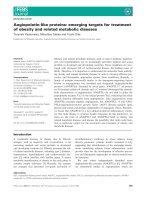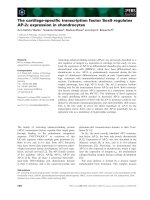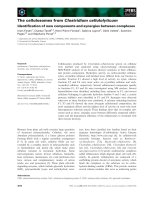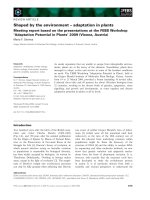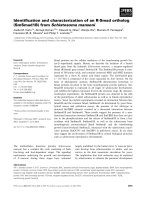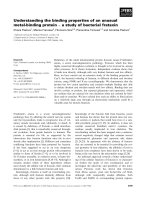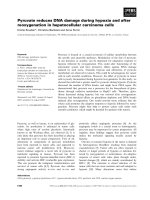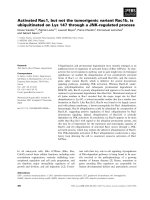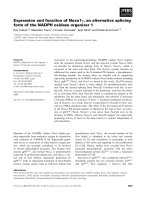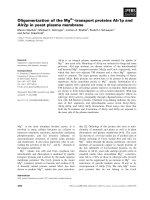Tài liệu Báo cáo khoa học: "Knowledge Acquisition from Texts : Using an Automatic Clustering Method Based on Noun-Modifier Relationship" pptx
Bạn đang xem bản rút gọn của tài liệu. Xem và tải ngay bản đầy đủ của tài liệu tại đây (282.13 KB, 3 trang )
Knowledge Acquisition from Texts : Using an Automatic
Clustering Method Based on Noun-Modifier Relationship
Houssem Assadi
Electricit4 de France - DER/IMA and Paris 6 University - LAFORIA
1 avenue du G4n4ral de Gaulle, F-92141, Clamart, France
houssem, assadi@der, edfgdf, fr
Abstract
We describe the early stage of our method-
ology of knowledge acquisition from techni-
cal texts. First, a partial morpho-syntactic
analysis is performed to extract "candi-
date terms". Then, the knowledge engi-
neer, assisted by an automatic clustering
tool, builds the "conceptual fields" of the
domain. We focus on this conceptual anal-
ysis stage, describe the data prepared from
the results of the morpho-syntactic analy-
sis and show the results of the clustering
module and their interpretation. We found
that syntactic links represent good descrip-
tors for candidate terms clustering since
the clusters are often easily interpreted as
"conceptual fields".
1 Introduction
Knowledge Acquisition (KA) from technical texts
is a growing research area among the Knowledge-
Based Systems (KBS) research community since
documents containing a large amount of technical
knowledge are available on electronic media.
We focus on the methodological aspects of KA
from texts. In order to build up the model of the
subject field, we need to perform a corpus-based
semantic analysis. Prior to the semantic analysis,
morpho-syntactic analysis is performed by
LEXTER,
a terminology extraction software (Bourigault et al.,
1996) : LEXTER gives a network of noun phrases
which are likely to be terminological units and which
are connected by syntactical links. When dealing
with medium-sized corpora (a few hundred thousand
words), the terminological network is too volumi-
nous for analysis by hand and it becomes necessary
to use data analysis tools to process it. The main
idea to make KA from medium-sized corpora a feasi-
ble and efficient task is to perform a robust syntactic
analysis (using LEXTER, see section 2) followed by a
semi-automatic semantic analysis where automatic
clustering techniques are used interactively by the
knowledge engineer (see sections 3 and 4).
We agree with the differential definition of seman-
tics : the meaning of the morpho-lexical units is
not defined by reference to a concept, but rather
by contrast with other units (Rastier et al., 1994).
In fact, we are considering
"word usage rather than
word meanin]'
(Zernik, 1990) following in this the
distributional point of view, see (Harris, 1968), (Hin-
dle, 1990).
Statistical or probabilistic methods are often used
to extract semantic clusters from corpora in order
to build lexical resources for ANLP tools (Hindle,
1990), (Zernik, 1990), (Resnik, 1993), or for au-
tomatic thesaurus generation (Grefenstette, 1994).
We use similar techniques, enriched by a prelimi-
naxy morpho-synta~ztic analysis, in order to perform
knowledge acquisition and modeling for a specific
task (e.g. : electrical network planning). Moreover,
we are dealing with language for specific purpose
texts and not with general texts.
2 The morpho-syntactic analysis :
the LEXTER software
LEXTER is a terminology extraction software (Bouri-
gault et al., 1996). A corpus of French texts on any
technical subject can be fed into it. LEXTER per-
forms a morpho-syntactic analysis of this corpus and
gives a network of noun phrases which are likely to
be terminological units.
Any complex term is recursively broken up into
two parts
:
head (e.g. PLANNING in the term RE-
GIONAL
NETWORK PLANNING),
and expansion (e.g.
REGIONAL in
the
term REGIONAL NETWORK) 1
This analysis allows the organisation of all the
candidate terms in a network format, known as the
XAll the examples given in this paper are translated
from French.
504
"terminological network". Each analysed complex
candidate term is linked to both its head (H-link)
and expansion (E-link).
LEXTER alSO extracts phraseological units (PU)
which are "informative collocations of the candidate
terms". For instance, CONSTRUCTION OF THE HIGH-
VOLTAGE LINE is a PU built with the candidate term
HIGH-VOLTAGE LINE.
PUs
are recursively broken up
into two parts, similarly to the candidate terms, and
the links are called H'-link and E'-link.
3 The data for the clustering module
The candidate terms extracted by LEXTER can be
NPs or adjectives. In this paper, we focus on NP
clustering. A NP is described by its "terminological
context". The four syntactic links of LEXTER Can be
used to define this terminological context. For in-
stance, the "expansion terminological context" (E-
terminological context) of a NP is the set of the can-
didate terms appearing in the expansion of the more
complex candidate term containing the current NP
in head position. For example, the candidate terms
(NATIONAL NETWORK, REGIONAL NETWORK, DIS-
PATCHING NETWORK) give the context (NATIONAL,
REGIONAL, DISPATCHING) for the noun NETWORK.
If we suppose that the modifiers represent special-
isations of a head NP by giving a specific attribute
of it, NPs described by similar E-terminological con-
texts will be semantically close. These semantic sim-
ilarities allow the KE to build conceptual fields in the
early stages of the KA process.
The links around a NP within a PU are also inter-
esting. Those candidate terms appearing in the head
position in a PU containing a given NP could de-
note properties or actions related to this NP. For in-
stance, the PUs LENGTH OF THE LINE and NOMINAL
POWER OF THE LINE show two
properties
(LENGTH
and NOMINAL POWER) of the object LINE; the PU
CONSTRUCTION OF THE LINE shows an action (CON-
STRUCTION) which can be applied to the object
LINE.
This definition of the context is original compared
to the classical context definitions used in Informa-
tion Retrieval, where the context of a lexical unit is
obtained by examining its neighbours (collocations)
within a fixed-size window. Given that candidate
terms extraction in LEXTER is based on a morpho-
syntactical analysis, our definition allows us to group
collocation information disseminated in the corpus
under different inflections (the candidate terms of
LEXTER are lemmatised) and takes into account the
syntactical structure of the candidate terms. For in-
stance, LEXTER extracts the complex candidate term
BUILT DISPATCHING LINE, and analyses it in (BUILT
(DISPATCHING LINE));
the adjective BUILT will ap-
pear in the terminological context of DISPATCHING
LINE and not in that of DISPATCHING. It is obvi-
ous that only the first context is relevant given that
BUILT characterises the DISPATCHING LINE and not
the DISPATCHING.
To perform NP clustering, we prepared two data
sets : in the first, NPs are described by their E-
terminological context; in the second one, both the
E-terminological context and the H'- terminological
context (obtained with the H'-link within PUs) are
used. The same filtering method 2 and clustering
algorithm are applied in both cases.
Table 1 shows an extract from the first data set.
The columns are labelled by the expansions (nominal
or adjectival) of the NPs being clustered. Each line
represents a NP (an individual, in statistical terms) :
there is a '1' when the term built with the NP and
the expansion exists (e.g. REGIONAL NETWORK is
extracted by
LEXTER),
and a '0' otherwise ("national
line" is not extracted by
LEXTER).
NATIONAL DISPATCHING REGIONAL
LINE 0 1 0
NETWORK 1 1 1
Table 1: example of the data used for NP clustering
In the remainder of this article, we describe the
way a KE uses LEXICLASS to build "conceptual
fields" and we also compare the clusterings obtained
from the two different data sets.
4 The conceptual analysis : the
LEXICLASS software
LEXICLASS is a clustering tool written using C lan-
guage and specialised data analysis functions from
Splus
TM
software.
Given the individuals-variables matrix above, a
similarity measure between the individuals is calcu-
lated 3 and a hierarchical clustering method is per-
formed with, as input, a similarity matrix. This kind
of methods gives, as a result, a classification tree (or
dendrogram) which has to be cut at a given level in
order to produce clusters. For example, this method,
applied on a population of 221 NPs (data set 1) gives
2This filtering method is mandatory, given that
the chosen clustering algorithm cannot be applied to
the whole terminological network (several thousands of
terms) and that the results have to be validated by hand.
We have no space to give details about this method, but
we must say that it is very important to obtain proper
data for clustering
3similarity measures adapted to binary data are used
-
e.g. the Anderberg measure - see (Kotz et al., 1985)
505
21 clusters, figure 1 shows an example of such a clus-
ter.
i
AN AUTOMATICALLY FOUND ~ OUTPOST NETWORK
CLUSTER
,
BAR STANDBY
',
CABLE
PRIMARY
', LINK TRANFORMER
UINE TRANSFORMATION
LEVEL UNDERGROUND CABLE
',
STRUCTURE
PART
INTERPRETATION BY TI~ KNOWLEDGE ENGINEER
STRUCTUI~S und~g~Lmd ~1~
Figure 1: a cluster interpretation
The interpretation, by the KE, of the results given
by the clustering methods applied on the data of ta-
ble 1 leads him to define conceptual fields. Figure 1
shows the transition from an automatically found
cluster to a conceptual field : the KE constitutes
the conceptual fields of "the structures". He puts
some concepts in it by either validating a candidate
term (e.g.
LINE), or
reformulating a candidate term
(e.g. PRIMARY is an ellipsis and leads the KE to cre-
ate the concept primary substation). The other
candidate terms are not kept because they are con-
sidered as non relevant by the KE. The conceptual
fields have to be completed all along the KA pro-
cess. At the end of this operation, the candidate
terms appearing in a conceptual field are validated.
This first stage of the KA process is also the oppor-
tunity for the KE to constitute synonym sets : the
synonym terms are grouped, one of them is chosen
as a concept label, and the others are kept as the
values of a generic attribute labels of the considered
concept (see figure 2 for an example).
l line
//conceptual field// : structure
//typell
: object
//labels// : LINE, ELECTRIC LINE,
OVERHEAD LINE
Figure 2: a partial description of the concept "line"
5 Discussion
• Evaluation of the quality of the clustering pro-
cedure • in the majority of the works using clus-
tering methods, the evaluation of the quality of
the method used is based on recall and preci-
sion parameters. In our case, it is not possi-
ble to have an a priori reference classification.
The reference classification is highly domain-
and task-dependent. The only criterion that we
have at the present time is a qualitative one :
that is the usefulness of the results of the clus-
tering methods for a KE building a conceptual
model. We asked the KE to evaluate the quality
of the clusters, by scoring each of them, assum-
ing that there are three types of clusters :
1. Non relevant clusters.
2. Relevant clusters that cannot be labelled.
3. Relevant clusters that can be labelled.
Then an overall clustering score is computed.
This elementary qualitative scoring allowed the
KE to say that the clustering obtained with the
second data set is better than the one obtained
with the first.
LEXICLASS is
a generic clustering module, it
only needs nominal (or verbal) compounds de-
scribed by dependancy relationships. It may
use the results of any morpho-syntactic analyzer
which provides dependancy relations (e.g. verb-
object relationship).
The interactive conceptual analysis : in the
present article, we only described the first step
of the KA process (the "conceptual fields" con-
struction). Actually, this process continues in
an interactive manner : the system uses the
conceptual fields defined by the KE to compute
new conceptual structures; these are accepted
or rejected by the KE and the exploration of
both the terminological network and the docu-
mentation continues.
References
Bourigault D., Gonzalez-Mullier I., and Gros C.
1996. Lexter, a Natural Language Processing Tool
for Terminology Extraction. In Proceedings of
the 7th Euralex International Congress, GSteborg,
Sweden.
Grefenstette G. 1994. Explorations in Automatic
Thesaurus Discovery. Kluwer Academic Publish-
ers, Boston.
Harris Z. 1968. Mathematical Structures of Lan-
guage. Wiley, NY.
Hindle H. 1990. Noun classification from predicate-
argument structures. In 28th Annual Meeting
of the Association for Computational Linguistics,
pages 268-275, Pittsburgh, Pennsylvania. Associ-
ation for Computational Linguistics, Morristown,
New Jersey.
Kotz S., Johnson N. L., and Read C. B. (Eds). 1985.
Encyclopedia of Statistical Sciences. Vol.5, Wiley-
Interscience, NY.
Rastier F., Cavazza M., and Abeill@ A. 1994. S~-
mantique pour l'analyse. Masson, Paris.
Resnik P. 1993. Selection and Information : A
Class-Based Approach to Lexical Relationships.
PhD Thesis, University of Pennsylvania.
Zernik U. 1993. Corpus-Based Thematic Analysis.
In Jacobs P. S. Ed., Text-Based Intelligent Sys-
tems. Lawrence Erlbaum, Hillsdale, NJ.
506
